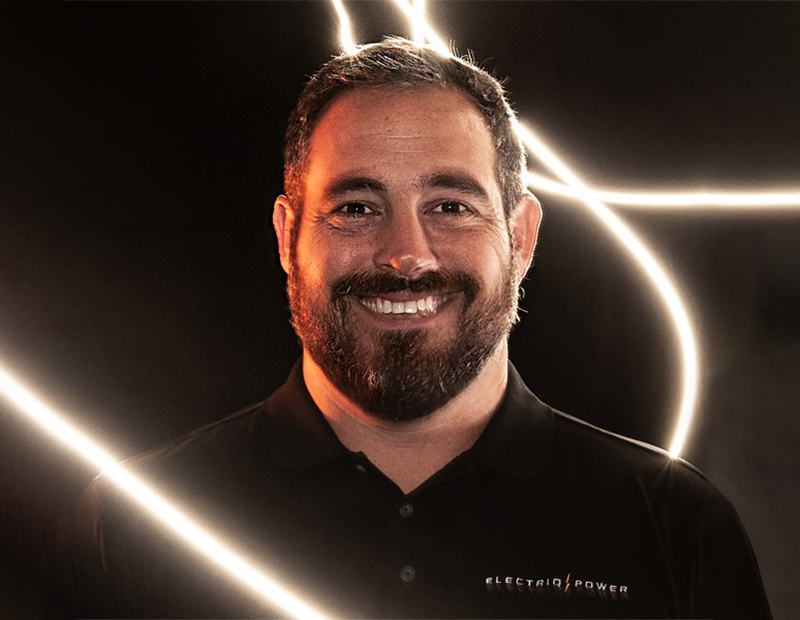Preparing for the Next Storm While Addressing Climate Change
Electriq Power's Aric Saunders shares his insights into the evolving energy storage market.

Aric Saunders, Executive Vice President of Sales & Marketing, Electriq Power. Image courtesy of Electriq Power
Microgrids and battery storage, once used in remote areas to power off-grid villages, military operations or industrial projects, are now being used in cities and towns, urban centers, university or corporate campuses, hospitals and data centers. They keep the lights on when the power goes out. We wanted to know more about the battery storage industry, so we reached out to Electriq Power and had an in-depth conversation with Aric Saunders, executive vice president of sales & marketing.
Like other iconic Californian firms, Electriq Power started in a garage. This was back in 2014. Tell us more about your journey so far.
Saunders: The company was founded in a garage with two totaled Nissan Leaf cars. Originally, we were looking at creating superchargers using old or abandoned electric vehicle batteries. Like many startups, we pivoted to the residential energy storage market after a few months, still hoping to use recycled batteries.
Unfortunately, at the time, there was very little cost advantage to taking those old batteries and refurbishing them to meet the demands of a residential stationary battery versus an EV battery. Since late 2014, we’ve been focused on creating the best residential energy storage solution through advanced hardware and best-in-class software.
Our early days of tinkering with different inverters and batteries have led us down a path of identifying the best hardware technology on the market while utilizing our software and firmware capabilities. By maximizing value and enhancing user experience, we can offer a solution that not only benefits the homeowner but the utility and grid as a whole.
 Energy storage has advanced a long way but is far from reaching its peak. Where are we currently and how do you see things evolving in the energy storage market?
Energy storage has advanced a long way but is far from reaching its peak. Where are we currently and how do you see things evolving in the energy storage market?
Saunders: Today, energy storage is growing rapidly. We’ve seen eight straight quarters of growth even during the pandemic. In fact, 2020’s second quarter set a record for the most residential energy storage systems deployed in the country. The industry surpassed the $1 billion mark in revenue this year.
Despite these great numbers, most systems are located in only a few markets, mainly California, Hawaii, Florida, Puerto Rico and parts of the Northeast. Most sales are also area-grouped, but we’re gradually seeing broader interest across the country. The Midwest is also rising, we’re now seeing consistent volume throughout the region.
READ ALSO: ESA Vision: 100 GW of New Energy Storage in 10 Years
The primary drivers are the increase in severe storms and fires with extended power outages, system prices going down and net metering rates coming under attack across the country. Combined, these provide an incentive to store and use self-generated power.
What barriers still need to be removed before the technology can be made even more available to power utilities?
Saunders: Utilities are actively deploying battery systems, and not just in small pilots. In California alone, after the Public Safety Power Shutoffs in October 2019, many Community Choice Aggregators issued RFPs for behind-the-meter energy storage that can be aggregated and offered as a grid resource.
In September this year, FERC ruled that utilities and wholesale markets must treat distributed energy resources, such as energy storage, as an asset class equal to any other asset available today. This is a far-reaching ruling that will have a dramatic impact on energy storage deployments in the coming years.
One other issue currently affecting power utilities from deploying residential or small commercial battery systems is the fact that most regulated utilities are not allowed to own behind-the-meter assets like our batteries. This is a somewhat controversial issue in the industry, as utility ownership could be detrimental to competition and customer choices, however, it would drastically increase energy storage deployments across the country.
What’s the level of involvement of the federal government in backing up the industry?
Saunders: Currently, energy storage is riding on the existing Federal Investment Tax Credit that was put in place for solar. That incentive is currently at 26 percent in 2020 and 22 percent for 2021. After that, it is scheduled to sunset for residential systems and continue at 15 percent for commercial systems. Multiple bills have been proposed to either extend the ITC or replace it with a storage-focused incentive.
A cleaner, more distributed power system is in the country’s best interest for grid security and resiliency. We’re optimistic that there is enough bipartisan support for solutions that increase our national security while creating a substantial number of highly skilled jobs and that we will see additional support from the federal government.
 Which are the most challenging aspects of the energy storage presently?
Which are the most challenging aspects of the energy storage presently?
Saunders: Educating customers on all the benefits available from a battery system, which is a tougher challenge than understanding how solar provides value. Because everyone knows how much their electric bill is and can calculate solar costs and kilowatt/hour generation, solar benefits and ROI are easier to conceptualize. Batteries can help with monthly bill savings with Time-of-Use rate tariffs, but today, a larger portion of the value is more subjective. For example, the value of resiliency and energy security is different for every person, even within the same household.
On top of monthly bill savings and backup power, grid service programs are being developed in which the utility pays you for the right to use your battery when you aren’t. Within grid services, there will be opportunities to not only send surplus power to the grid but also to take on excess power during the day at a point when electricity may be even cheaper. Many of these programs are being piloted right now and won’t be live for a couple of years, but the value is intrinsic to the system. The way we see it, every year, the value of a battery system will actually be increasing as more incentive programs are launched.
The other considerable challenge is the inconsistency in permitting across jurisdictions. Many Authorities Having Jurisdiction entities, especially in growing markets, have never installed a battery and set unrealistic demands for the siting and installation of systems. These demands slow deployments and installations drastically and ultimately deter homeowners from taking on the projects.
Tell us about one of the most intricate projects you’ve worked on.
Saunders: A few projects come to mind, as they are unique or exciting. One really took full advantage of the PowerPod from a design and control perspective. This customer wanted to back up their entire home with a solar and battery system. However, they had several larger loads, including a couple of air conditioners. Most battery systems today back up 20 to 30A of load at any given time. On this site, we stacked three of our PowerPods together to allow the customer the ability to back up almost 70A of continuous loads.
Not only did we provide them with a bigger system that could deliver more than the average load but we also integrated a smart load panel that managed 12 circuits within their home to help either reduce loads to remain under 70A or reduce consumption to make the battery last longer during an outage. Just because you can use 70A doesn’t mean you want to if you know you’ll have an extended outage. By utilizing our monitoring platform, the customer can see exactly how long their battery will last and use the smart load panel to control loads remotely to adjust their consumption in real-time.
You’ve recently entered an agreement with Emergent Microgrid, which means that you’ll have an entire new portfolio under your responsibility. How will things unfold for Electriq Power and Emergent Microgrid going further?
Saunders: We’re really excited about the projects and opportunities we will be able to pursue soon. Emergent Microgrid brings not only the value of their existing portfolio but their expertise and knowledge in the microgrid market. Now we have this pathway forward into deployment and control of our systems while maximizing the value for microgrids.
READ ALSO: High-Tech, High-Powered Changes
Outstanding climate events, such as hurricanes and wildfires, have been acting as a booster for the adoption of home battery storage and microgrids, especially in California, where a Public Safety Power Shutoffs program has been adopted last year. Tell us more about this program and its impact on the local energy storage industry.
Saunders: The PSPS brought the reality of the current climate situation into the home of every Californian. There are two overarching issues at play here: One, that fire season is getting worse every year—the climate is changing and we’re feeling the direct impact. And two, the centralized grid design is antiquated, and despite one of the most progressive policies on solar and storage, utilities are still moving very slowly to a distributed grid. Instead of having a grid that is stable and reliable, we have a grid that makes two million people lose power when winds are high in one area.
PSPS has caused a rapid increase in deployments in a short period of time when the industry is already facing not only a labor shortage but also a spike in demand for solar due to the step down in the federal ITC incentive. We’re not complaining, but it has created demand that outpaces supply and availability of qualified installers.
One example of this demand occurred in July when $270 million was released for the Self Generation Incentive Program, just in the PG&E territory. This money was originally intended to fund projects for the next four years, but the funds were officially depleted after just two months. All of this occurred during a pandemic.
People are losing hope in the grid being available and reliable for the foreseeable future and are taking steps to secure their homes with energy storage systems.
 How has COVID-19 impacted your firm?
How has COVID-19 impacted your firm?
Saunders: We’ve had to adjust the way we operate on a day-to-day basis, but it has also driven us to be innovative in our approach to the market. We focused on developing online content, webinars and tools to help our customers, installers, and distributors learn more about our product remotely. These were all projects we had in the works for a long time but never had time to execute.
Deliveries, installations, sales calls and internal meetings were put on hold when the shelter-in-place orders hit, allowing us time to focus on developing these tools. In a matter of a few weeks, we built out our YouTube channel, created a webinar series and an educational video series for customers.
READ ALSO: How Energy Storage is Navigating the Pandemic
Although things slowed down in the second quarter, we’ve had our most profitable months and quarters this year. 2020 will be our best year to date. From what I’ve heard, this will be the case for everyone in the industry. Again, it’s brought to light the fragility of the world we live in. Increasing the resiliency of a person’s home has become a top priority, especially as we see the work from home orders extending and many of them becoming a part of the new normal.
How do you see the industry advancing in the shadow of the health crisis?
Saunders: This pandemic has been terrible in so many ways. Although it has been incredibly damaging to the economy, energy storage and renewable energy, in general, seem to be a bright spot. There are still things to work through—such as permitting—that aren’t moving smoothly due to the pandemic. But we’re seeing AHJs that have been very slow to adopt technology move more quickly to remote inspections or online permit applications than they were pre-pandemic.
The sales process has also been hampered since salespeople can’t sit at the kitchen table with customers anymore. But again, the firms that innovate are the ones that will thrive. Ultimately, we’re energized and encouraged by the way the industry has responded and the innovation that has been spurred on by this generational health crisis.







You must be logged in to post a comment.